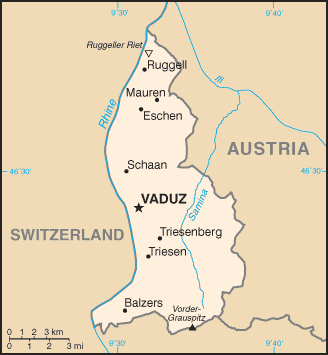Geography of Liechtenstein
This article was imported from the CIA's World Factbook. |


Location: Central Europe, between Austria and Switzerland
Geographic coordinates: 47°10′N 9°32′E / 47.167°N 9.533°E
Area: 160 km² (land, 0 km² water)
Land boundaries:
total:
76 km
border countries:
Austria 35 km, Switzerland 41 km
Coastline: 0 km (landlocked)
Maritime claims: none (landlocked)
continental; cold, cloudy winters with frequent snow or rain; cool to moderately warm, cloudy, humid summers, great variety of microclimates based on elevation
mostly mountainous (Alps) with Rhine Valley in western third
hydroelectric potential, arable land
Land use
arable land:
24%
permanent crops:
0%
permanent pastures:
16%
forests and woodland:
35%
other:
25% (1993 est.)
Irrigated land
NA km²
Natural hazards
NA
Environment - current issues
NA
Environment - international agreements
party to:
Air Pollution,
Air Pollution-Nitrogen Oxides,
Air Pollution-Sulphur 85, Air Pollution-Sulphur 94,
Air Pollution-Volatile Organic Compounds,
Biodiversity,
Climate Change,
Desertification,
Endangered Species,
Hazardous Wastes,
Ozone Layer Protection,
Wetlands,
signed, but not ratified:
Air Pollution-Persistent Organic Pollutants,
Climate Change-Kyoto Protocol,
Law of the Sea
Geography - note
Along with Uzbekistan, Liechtenstein is one of only two doubly landlocked countries in the world; great variety of microclimates based on elevation
Extreme points
- North - River Rhine 47°16′15″N 9°31′51″E / 47.27083°N 9.53083°E
- South - summit of Mazorakopf/Falknishorn (2452 m) 47°2′55″N 9°33′26″E / 47.04861°N 9.55722°E
- East - border post 28, above Nenzinger Himmel 47°2′55″N 9°33′26″E / 47.04861°N 9.55722°E
- West - River Rhine 47°3′46″N 9°28′18″E / 47.06278°N 9.47167°E
- highest - Vorder Grauspitz (2599 m) 47°3′10″N 9°34′54″E / 47.05278°N 9.58167°E
- lowest - Bangserfeld (429 m) 47°15′57″N 9°32′14″E / 47.26583°N 9.53722°E
